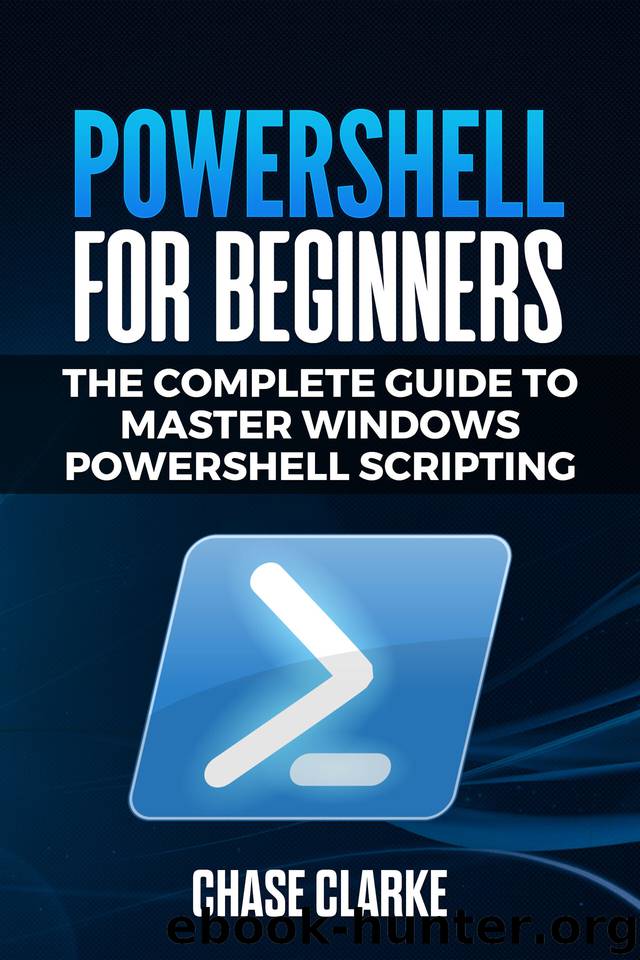PowerShell for Beginners: The Complete Guide to Master Windows PowerShell Scripting by Clarke Chase

Author:Clarke, Chase [Clarke, Chase]
Language: eng
Format: epub
Published: 2020-03-07T16:00:00+00:00
POWERSHELL PROVIDERS AND MODULES
Introducing Providers
E xactly when you hear the articulation "providers," I bet the non-fashioners among us (and I recall myself for this social occasion) start to shut out. That seems like something you do alongside making a class and starting up a for-circle with strings that go through a model view controller.
Yet, that is not the situation here. Let me unload this for you a smidgen, in any event with regards to PowerShell.
PowerShell suppliers are basically similar to drivers for the working framework, where you introduce some code to help your duplicate of Windows converse with the designs equipment, the capacity and circle subsystems, and the chipset on your motherboard. The drivers contain the "interpretation layer," which isn't an official term, with the goal that Windows realizes how to drive the equipment and make it work for your utilization.
PowerShell suppliers are drivers for PowerShell to explore things other than the record framework. Suppliers permit PowerShell to navigate the Registry, the File System, Windows Management Instrumentation (WMI) usefulness, and that's only the tip of the iceberg. Outsiders can make suppliers: For instance, there is a SQL Server supplier that Microsoft introduces that lets you do PowerShell procedure on databases.
How Providers Work
Suppliers take some assortment of something - whatever asset they are attempting to empower for PowerShell the executives - and make it resemble a record framework or circle drive to PowerShell. Suppliers are utilized by a wide range of programming bundles that help PowerShell for the organization, similar to Internet Information Services (Microsoft's webserver) and Active Directory.
This is one of PowerShell's key extensibility highlights, on the grounds that any asset or information to be overseen consistently appears like a drive. Furthermore, new directions can be included that communicate with similar information stockpiling, regardless of whether that is a database or a rundown of managerial settings for a site or a letterbox store or whatever else, truly. It's sort of cool.
How would you know what suppliers you as of now have? PowerShell does, without a doubt, transport with a few. You can utilize the Get-PSProvider direction to discover which ones.
Supplier Capacities And Drives
The names of the suppliers are genuinely self-evident. PowerShell can make every one of these things appear as though circle drives: Aliases, the earth (which incorporates natural factors like PATH and that's just the beginning), the FileSystem, capacities, the Registry, and any characterized factors. So I can reach in and contact information or records in any of these "places" just by cd:\ing around and adding way like explanations to find a good pace need to be. At the point when you utilize a supplier, you are actually making a PSDrive, and that PSDrive is the portrayal of the capacity or asset you are associating with as the document framework on a plate.
Capacities are a rundown of approaches to utilize, and things you can (and can't) do with every supplier. For the reasons for this article, we won't stress over them.
Drives, then again, are the consistent passage for suppliers.
Download
This site does not store any files on its server. We only index and link to content provided by other sites. Please contact the content providers to delete copyright contents if any and email us, we'll remove relevant links or contents immediately.
| Ada | Ajax |
| Assembly Language Programming | Borland Delphi |
| C & C++ | C# |
| CSS | Compiler Design |
| Compilers | DHTML |
| Debugging | Delphi |
| Fortran | Java |
| Lisp | Perl |
| Prolog | Python |
| RPG | Ruby |
| Swift | Visual Basic |
| XHTML | XML |
| XSL |
Hello! Python by Anthony Briggs(10192)
The Mikado Method by Ola Ellnestam Daniel Brolund(10094)
OCA Java SE 8 Programmer I Certification Guide by Mala Gupta(10034)
Algorithms of the Intelligent Web by Haralambos Marmanis;Dmitry Babenko(8581)
Sass and Compass in Action by Wynn Netherland Nathan Weizenbaum Chris Eppstein Brandon Mathis(7960)
Grails in Action by Glen Smith Peter Ledbrook(7938)
Test-Driven iOS Development with Swift 4 by Dominik Hauser(7887)
The Well-Grounded Java Developer by Benjamin J. Evans Martijn Verburg(7835)
Windows APT Warfare by Sheng-Hao Ma(7595)
Layered Design for Ruby on Rails Applications by Vladimir Dementyev(7333)
Blueprints Visual Scripting for Unreal Engine 5 - Third Edition by Marcos Romero & Brenden Sewell(7234)
Secrets of the JavaScript Ninja by John Resig Bear Bibeault(6722)
Kotlin in Action by Dmitry Jemerov(5366)
Solidity Programming Essentials by Ritesh Modi(4440)
Hands-On Full-Stack Web Development with GraphQL and React by Sebastian Grebe(4397)
WordPress Plugin Development Cookbook by Yannick Lefebvre(4248)
Unity 3D Game Development by Anthony Davis & Travis Baptiste & Russell Craig & Ryan Stunkel(4161)
Functional Programming in JavaScript by Mantyla Dan(4149)
The Ultimate iOS Interview Playbook by Avi Tsadok(4136)
